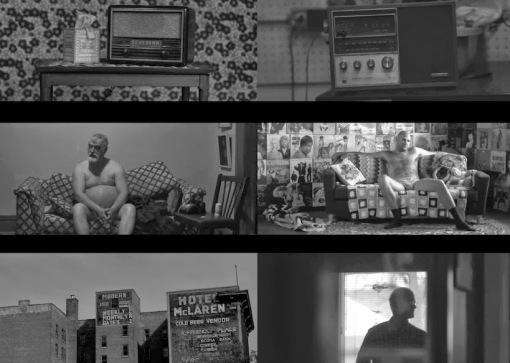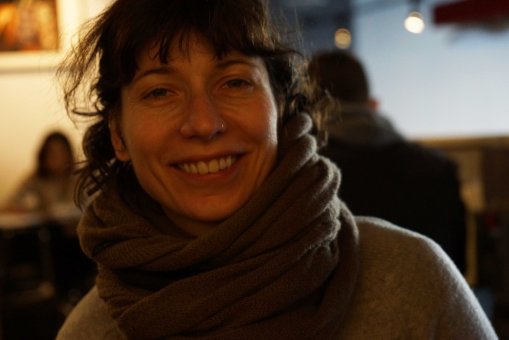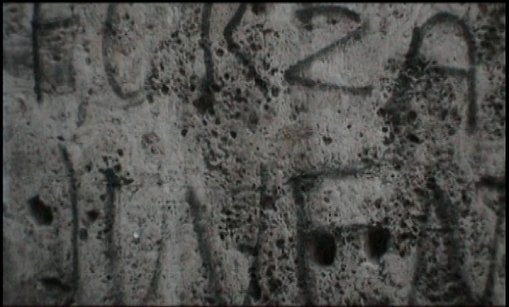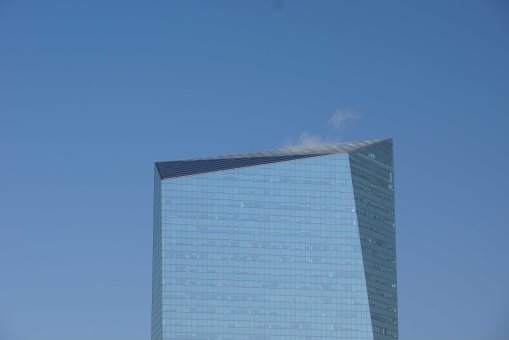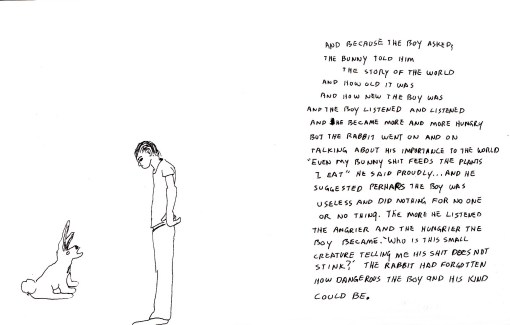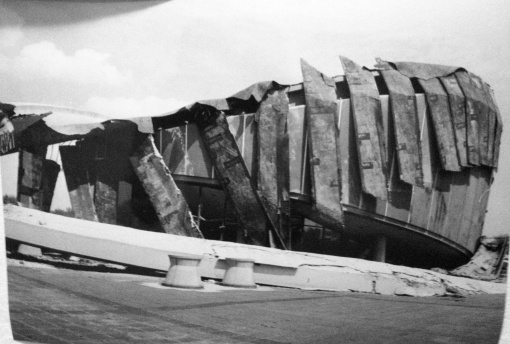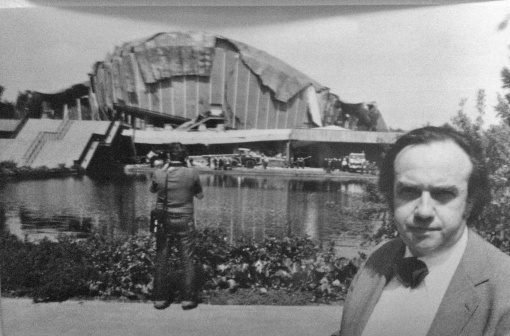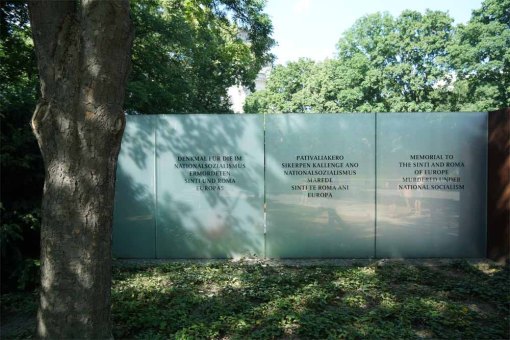 Peter Hutton, New York Portrait
Peter Hutton, New York Portrait
One of the virtues of the otherwise costly nature of New York City (or many other such places) is that one can see things elsewhere unavailable. And so the other evening I went with Daniel Levine and John Murphy to go see Godard’s latest film, at the Waverly IFC. Plunking down my $14 ($4 senior discount), grabbed my glasses and went in.
Saying “farewell to language” Jean-luc Godard pulls out all the stops, and within his particular small-bandwidth sandbox of ideas, cinematic tropes, conceits, and toys, he seemingly also says farewell to us. Adieu au Langage has the air of a terminal note, the signal of an old man, stogie permanently affixed in his mouth, playfully leaving his audience in the dust, to which he’s soon to be consigned, though film world rumor has it he is busy on another film. Here Godard as collagist deploys his cubist methods across the board: visually, aurally, spatially, intellectually. He leaves nothing at his disposal untouched by his simultaneous dyspeptic misanthropic cynicism and his joyful childlike play with his art. The combination is disarming, and begets a range of responses from “pretentious garbage” to “work of genius.”



 “the ones without imagination take refuge in reality “
“the ones without imagination take refuge in reality “
In his late period manner he releases a barrage of text, passages of lush music clipped off in mid-phrase, disorienting imagery, the customary naked young women’s bodies (men too, somewhat older), binary philosophical aphorisms, and his dog snooping around, pooping, and myriad other things delivered in rapid fire pacing, at times tongue deeply in cheek, at times profoundly “serious”. Adieu au Langage is a delirious, defiantly “unprofessional” home-movie, which cocks his cigar-smoke ringed nose at the narrow conventions of what most people think of as “cinema.” The play with 3D is particularly striking on many fronts, from the minimalist compositions that exaggerate 3D’s spatial qualities, to distended angles that make bodies seem not connected to themselves, to the two shots in which he pans one of the binary cameras to simultaneously shift from 3D to superimposed 2D. The second of these is much better for being less obvious – from what I have read many of our critics seem not to have even seen it. He’s been doing this kind of thing since Breathless, which of course in these days now seems almost conventional itself as its strategies long since entered the now-normal grammar of the movies. One doubts though that much of his play in this latest (last?) work will have legs outside the avant-garde/experimental world (from which he has heavily borrowed here).



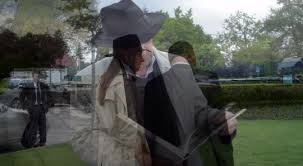
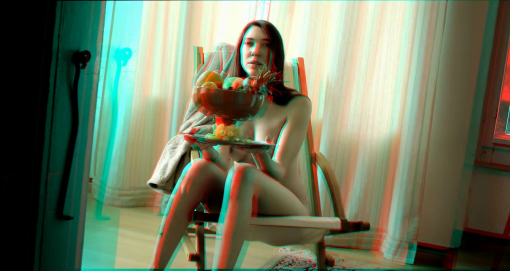
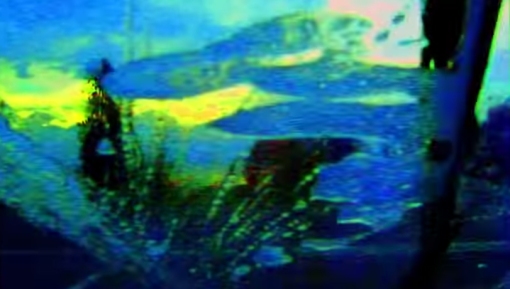
To see an old pro do his shtick with such consummate fun, is, for those those of us with a taste for such things, a profound pleasure. For myself I have found most of Godard’s work of the last few decades (yes, counting in decades now) an indigestible slog, but here there is an energy, a “joyful wisdom” that pervades those same old tropes he has deployed from the outset. An on-slaught of quotes from famed intellectuals are played upon, binary oppositions are ping-ponged (male/female; birth/death, 3D/not3D) as Godard weaves an intricate mesh of associations in a manner more music and/or poetry than the usual ho hum of narrative cinema. Though he persists on holding onto the hint of a slender thread of story, of theatrical devices, of boy-meets-girl, though the thread is so thread-worn that to find it takes far more than it is worth. Like that other artist on the film radar of the moment, Turner, Godard seems unable to just let go and surrender to cinematic abstraction. Better to skip trying to follow any “story” and simply let the images jar one’s eyes and mind, along with the willfully jagged sound that shifts left/right/stereo/silence/loud/quiet, and where the taboo’s of the professional cinema are ignored and windpops abound, electrical crackles slip through, a shot’s actor’s voice breaks up from digital mismanagement. And this time around the tid-bits of philosophic meandering actually manage in this grand poetic gesamtskunstwerk to acquire a modest force and poignancy. Perhaps it is the approaching end of life which coaxes this result, but here passion does indeed come rushing through the clutter of the artist’s looped obsessions.
In the latter half of the film the energy begins to run out, and Jean-luc shifts the burden onto his dog Roxy. We see Roxy nosing around here and there, in shots less riven with creative spark, and we get a bit of pooch philosophizing, with the assertion that “dogs are the only animal that love others more than themselves.” As with many Godardian aphorisms, from “cinema is the truth 24 times a second,” on, this one is snappy and quotable and simultaneously will not bear much examination. It ain’t true, but that has never deterred Jean-luc from coining a snappy phrase. While Roxy seems a nice enough dog – and I like dogs a lot – he isn’t quite hefty enough an artist himself to carry Godard’s weight on his back. While lightly peppered with further mental meanderings, the last 15 or 20 minutes of the film begins to sag, and I ponder whether its brief 70 minutes seemed much longer owing the the opening half’s dense filling that required a sprint to absorb, or whether it was the latter part which left one with a sense of diminishing returns, which did so. Or more likely the combination of the two.
But, if you can, my recommendation is go see.

 Goya
Goya
Notes:
“Godard was ostensibly attracted to 3-D because it remains unencumbered by any rules to speak of, but he eventually breaks its one implicit rule by drawing attention to the separation between the right-eye and left-eye images, most spectacularly in a mind-bending shot that I have yet to fully comprehend on a technical level (believe me: you’ll know it when you see it) and that actually drew a round of applause mid-screening in Cannes.” Kent Jones, Director NY Film Festival
.
Uh, there is nothing difficult about comprehending how the shot was done if you have even the most basic understanding of how 3D is shot: one of the two cameras panned, simple as that. Then it panned back.
Here’s a list of writings on the films I found of interest :
http://cinema-scope.com/spotlight/adieu-au-langage-jean-luc-godard-france/
http://www.thestar.com/entertainment/movies/2014/11/13/adieu_au_langage_is_a_doggone_absurd_godard_satire_review.html
http://www.slate.com/articles/arts/movies/2014/10/adieu_a_langage_jean_luc_godard_s_goodbye_to_language_in_3_d_reviewed.html
http://theflichttp://cpn.canon-europe.com/content/Jean-Luc_Godard.dokeringwall.blogspot.pt/2015/01/adieu-au-langage-goodbye-to-language.html
https://mubi.com/notebook/posts/cannes-2014-jean-luc-godards-adieu-au-langage
http://www.ferdyonfilms.com/2015/goodbye-to-language-adieu-au-langage-2014/23566/
And here, an interview with JLG himself, talking on technical and other matters:
http://cpn.canon-europe.com/content/Jean-Luc_Godard.do

And, being in New York, serendipitously I was here for the opening of an exhibition of three “video installations” by James Benning and Peter Hutton, at the Miguel Abreu Gallery on the lower East Side (88 Eldridge St, and 36 Orchard St), which has rapidly been gentrified. Orchard Street, where it is, is now lined with fancy-ass galleries. I went for the opening so I could see both of them – hadn’t seen James since shooting Coming to Terms in August 2012, and Peter since maybe 2004 or 5. The opening was the usual buzz of people, drinks in hand, saying “haven’t seen you since….” and other such things. It was pretty full when I passed by and I am sure more than 300 showed up to socialize, get some free beer, and “network.” Some actually sat to watch, though under adverse circumstances: openings are not a time to look at art. I suspect most of those who materialized did not go back to see the work. But I did.
Benning’s piece, Tulare Road, is three images from almost exactly the same place, as above, in a desolate valley in the central valley in California. 3 different days, one clouded as above, one foggy, and one with broken clouds. The triple images make a broad sweep on the wall. A car goes by in one; a lapse; truck in another. Occasionally two go by on separate screens. Owing to the atmospherics the sounds are slightly different. The light scarcely changes under the gray cover. I didn’t time but it is 20-30 minutes. I sat through the whole thing. I can’t say it was worth the time. One the other hand I have sat through Jame’s film RUHR, which has a one hour static shot of a steel mill facility to end it, and that was worth the time. Hit and miss. This one missed me by a mile. (I’d seen a glimpse of it 3 years ago I think in Jeonju where it was very poorly presented, with noise from adjacent things competing and light killing the image.)

Peter Hutton’s At Sea
Peter had two pieces, one which I had seen in early editing back in 2004 or so – At Sea. It then showed at the Whitney Biennial, and went on to garner lots of praise in the art world. When I saw it way back 10 years ago, I was far from impressed. Whether as a film on a single screen, or an “installation” in “3 channel” format, this just does not work for me. At risk of a friendship – I hope not – I must say I find the imagery here to be, at best, pedestrian (the only sequence approaching his earlier work is where some Indian ship-breakers approach his camera). Compared to his Images of Asian Music (much shot on shipboard), or his many amazing earlier films (July ’71 in San Francisco, Living at Beach Street, Working at Canyon Cinema, Swimming in the Valley of the Moon; New York Portraits 1&2, Lodz Symphony, Budapest Portrait, and others), At Sea is simply DOD. Having it on 3 screens does nothing to enhance it. The other film/installation, 3 Landscapes, suffers similarly. 3 places – Detroit, some place in the Middle East with people putting salt on camels, and then some farming area, I don’t know where. Lackadaisical images strung together in something I could hardly call editing. Like watching rushes from a just-competent student.
I know these are harsh words, and I know some differ with me. But I know Peter’s early work, which was magic. (I wrote for publication, the AFI Magazine, about his work in the early 70’s.) And I know this recent work simply is not. With my critic hat on, I wonder and think it was, in part, the shift from the Tri-X black and white stock, which he used to extraordinary effect (and hardly doing so properly – with my filmmaker hat on I know he drastically underexposed – 1.5 to 2.5 stops – to get a rich, dense array of very grainy grays, and an eye for what visuals would dance beautifully with the dance of the granularity and palette of black to gray), which accounts for the sudden change. The magic relation to his medium is utterly absent in the color films, as is any sense of playing/using the qualities of those film stocks he uses now to secure some similar qualities.
 New York Portrait
New York Portrait
As a filmmaker I am very aware of how critics see the world, and how summary their judgements tend to be. I think in my life, since around 1995 or so, I’ve simply been written off, mostly because almost all previously sort-of supportive critics simply haven’t seen my work since I shifted from 35mm to DV. This has in part to do with some major shifts in our total social cultural envelope in which Market Economy Neo-Liberal/Con values have come to dominate our society. In practical terms this means if one’s work (as a filmmaker) isn’t opening in a commercial cinema, and isn’t concerned with making as much money as possible, one won’t get reviewed. Twenty years ago had I come to New York, to show in some non-commercial place, I likely would have gotten a review from a handful of critics – Jim Hoberman, Amy Taubin, Manohla Dargis, or whomever was doing the off-Hwd reviews for the NY Times, or even in the NY Post. Today, nada. Nothing. (This is, whether one agrees or not, an ideological and political matter – see this recent blog post: on-becoming-a-non-person-part-1/ .)
In turn, one simply is written off. In effect one doesn’t exist. In a similar manner, there is a tendency, when and if one’s work is actually seen, to judge, like Hollywood, by the last work – was it good, worse, etc. Is the artist failing in his dotage? There is the underlying thought that one should on every outing make a masterpiece. And if not, holy hell descends. One is washed up, the creative well has run dry, and crap like that – and this is bad and reflects badly on the artist. There seems almost no consciousness that art-making is very much an organic matter, and it is not a mechanical matter with an on/off button. Some artists make something brilliant when they are 20 (Rimbaud) and shortly disappear; some make good things and get better, and then dwindle out; some do good work when young and persist deep into old age; some do nothing of note, and at 80 do something amazing. It runs the full spectrum. And there is nothing whatsoever bad/shameful to burn out, whether at 25 or 85, and hang up the spurs. What, perhaps, is bad, is the pressure that exists to continue to produce when the spark is no longer there, and perhaps to fail to see that one’s time is done.
For myself, when that time comes, I’ll write the creative obit myself and be done. Ironically given my recent work, I’d have to say I’m doing some of my best work, hands-down, in a world which could care less because that work isn’t calculated to make the loudest noise or the biggest buck. C’est la fkn vie.




